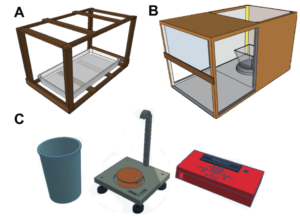
PhenoRig, PhenoCage, and AWWEsmo
Phenotyping, which involves assessing observable plant characteristics, is crucial for understanding plant development and response to environmental stresses. Traditional methods are often cumbersome, costly, and destructive, limiting research scope and scale. A new system of affordable, mobile, and high-throughput phenotyping tools is making the technology accessible to a wider range of users.
The “all-in-one” solution, developed by a team at the Boyce Thompson Institute (BTI), includes low-cost hardware designs, data processing pipelines, and a user-friendly data analysis platform. BTI’s system captures data without harming plants, allowing continuous monitoring of plant growth and providing a nuanced understanding of plant responses over time. The integration of simple hardware with sophisticated computational pipelines creates an effective high-throughput phenotyping solution.
“By lowering the cost and technical barriers of advanced plant phenotyping, our work empowers researchers worldwide to conduct affordable, data-driven studies,” said Magda Julkowska, an assistant professor at BTI and co-lead author of the study. “This could accelerate the breeding of more resilient and productive crops, enhancing food security in a sustainable way.”
Using their new phenotyping toolset, the research team analyzed the drought resilience of cowpeas, a staple food crop for millions in arid regions. They identified several genetic loci linked to drought response, paving the way for breeding more resilient varieties. These results and the details of their innovative platform were recently published in Plant Physiology.
“This technology could help transform regions where water scarcity threatens food security by enabling localized, cost-effective research into crop performance under stress conditions,” noted Li’ang Yu, a postdoctoral scientist at BTI and co-first author of the study. “The system’s adaptability means it can be used for various species, from staple crops to less common plants.”
One of the system’s standout features is its integration with computational pipelines designed for ease of use. Hayley Sussman, a BTI scientist and co-first author of the study, explains, “The RaspiPheno App we developed streamlines data analysis, offering an interactive platform for processing and visualizing phenotypic data. This shortens the learning curve and lets researchers focus on biological insights rather than technical hurdles.”
Looking ahead, the team is excited for others to adopt and build upon this system. All hardware designs, software, and detailed protocols have been made publicly available. “By making these tools open-access, we hope to enable novel discoveries and collaborations that can help tackle some of the major challenges facing agriculture today,” said Andrew Nelson, an assistant professor at BTI and co-lead author of the study.
The team’s work is a compelling example of how improving phenotyping technologies can accelerate plant biology research and translation. As more scientists leverage these tools, we can expect faster progress in understanding key traits and developing more resilient, productive crop varieties for the future.
The work is supported by the USDA National Institute of Food and Agriculture, and the Goelet Foundation has supported the work on developing affordable phenotyping systems.
